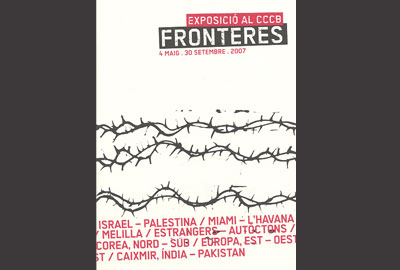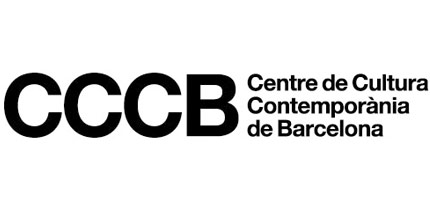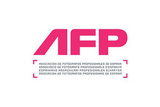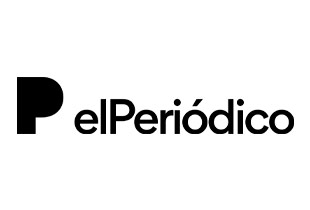Exhibition
Borders
“The examination of boundaries we propose in this exhibition is an exploration of borderline territories which somehow express the contradictions of a world that moves between hypercommunication and deep schism. The closer we move together, the more labyrinthine the world becomes.”
The CCCB presents the exhibition Borders, a reflection on the concept of the border, its types and a review of some of today's geopolitical borders (the boundaries of Europe, US-Mexico, Israel-Palestine, North Korea-South Korea, Kashmir, Miami-Havana, the case of Melilla...).The exhibition is designed as a journey through different worlds, in a movement that brings together history and geopolitics, the gaze of photographers and eye-witnesses, sounds and maps, general reflections and field studies.
Borders, curated by the French geographers Michel Foucher and Henri Dorion, is a co-production of the CCCB and the Musée des Confluences de Lyon (Département du Rhône), which was presented from 3 October 2006 to 4 February 2007. It will run at the CCCB from 4 May to 30 September 2007.
Activity related to Border MusicCurators: Henri Dorion, Michel Foucher
The exhibition begins with a mural by Josep Niebla: Patera no. 1
1 - THE BOUNDARIES OF EUROPE
The borders of Europe and the question of its boundaries: from the Aegean Sea to the Barents Sea. Screening of photographs by Frédéric Sautereau who, together with the journalist Guy-Pierre Chomette, undertook a journey between June 2000 and August 2003, during which they followed the borders of Eastern Europe.
2 - CLANDESTINE ITINERARIES
The challenges of migration in the world (the European case): images of Kingsley's journey around Cameroon, Niger, Nigeria, across the Sahara, Algeria, Morocco, the Western Sahara and across the Atlantic.
Photographs by Olivier Jobard with voice-over by Kingsley
3 - THE LAST PARADISE
Borders that remain closed: North Korea is one of the last examples of an isolated world, hermetically closed by militarized borders that are almost impassable to its inhabitants, where the regime maintains an autarchy characteristic of bygone days and reserves the benefits of foreign contact for a minority.
Screening of photographs by Nicolas Righetti
4 - KASHMIR
Territorial conflicts-forgotten paradise. The war in Kashmir is probably one of the oldest territorial conflicts. Since the partition of India in 1947, it has seen the confrontation of Pakistan, India and Kashmiri separatist guerrilla movements.
Photographs by Marie Dorigny
5 - A BORDER IN THE MAKING: ISRAEL AND PALESTINE
A unique case in the world of the physical formation, before our eyes, of a cement boundary, reinforced by passing places with sophisticated equipment, the prelude to a border between a state and an institution that aspires to statehood.
Photographs by Olivier Coret with the background sound from around the wall
6 - THE NORTH. THE US-MEXICO BORDER
The economic challenges of borders as a result of globalization. Unemployed Mexicans aspire to a better life on the other side of the border and American companies exploit cheap labour on both sides of the line. But this is an age in which differences between neighbouring societies generate migratory movements, which some people consider too large. And it is at this point that the border becomes a wall.
Photographs by Patrick Bard and screening of a film by the same author
7 - REAL CHRONICLES OF AN IMAGINARY COUNTRY
The world of landless peoples: gypsies scattered throughout Europe.
Photographs by Éric Roux-Fontaine.
8 - EXILE
Permeable and hard borders: the exile of refugees.
Photographs by Michel Séméniako
9 - OCEANMALECONDRIVE
An installation designed by Enric Massip and Ángel Morúa contrasts the seafronts of Havana's Malecón and Ocean Drive, Miami Beach, forming a "border street".
10 - MELILLA
The fence in Melilla: three successive rows of wire fencing. The tallest is seven metres high. On one side, the Moroccan army controls the perimeter, on the other lies the sea of wildest dreams. Beyond the fence, on the outskirts of the cities of Morocco and Algeria, improvised camps hide people who, one day, set out on a journey in search of a decent life.
11 -Audiovisual installation with original work and artistic direction by Frederic Amat
Produced on the basis of the lectures given as part of the "Borders" cycle, which took place at the CCCB from 12 January and 29 March 2004 in the framework of the 7th Barcelona Debate, with the participation of the following speakers: Roger Bartra, Zygmunt Bauman, Georges Corm, Manuel Cruz, Francisco Fernández Buey, Michel Foucher, David S. Landes, Tzvetan Todorov and Eyal Weizman.
Related contents
Report "Borders"
The CCCB presents the exhibition "Borders", a reflection on the concept of the border, its types and a review of some of today's geopolitical borders (the boundaries of Europe, US-Mexico, Israel-Palestine, North Korea-South Korea, Kashmir, Miami-Havana, the case of Melilla...). The exhibition ...
David S. Landes
In the framework of Audiovisual installation by Frederic Amat
Produced on the basis of the lectures given as part of the "Borders" cycle, which took place at the CCCB from 12 January and 29 March 2004 in the framework of the 7th Barcelona Debate, with the participation of the following speakers: Roger Bartra, Zygmunt Bauman, Georges Corm, Manuel Cruz, Francisco Fernández Buey, Michel Foucher, David S. Landes, Tzvetan Todorov and Eyal Weizman.






